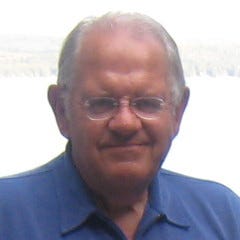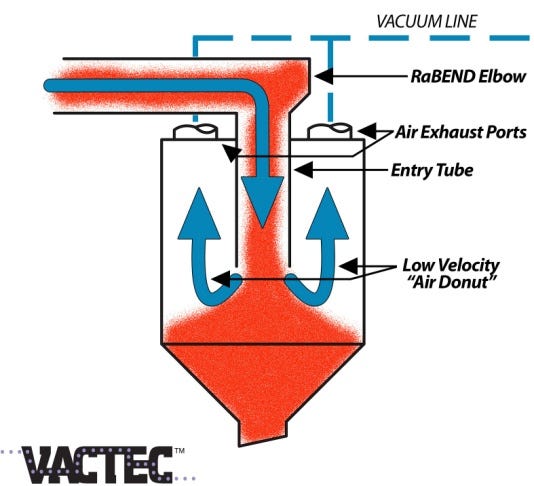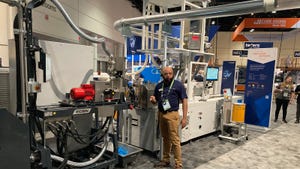Resin handling is not a dry issue for Chuck Thiele
Chuck Thiele talks about resin conveying, drying, and blending the way that Boomer Esiason talks about NFL quarterbacks and Lee Iacocca used to talk about cars. With passion.
January 6, 2014
Chuck Thiele talks about resin conveying, drying, and blending the way that Boomer Esiason talks about NFL quarterbacks and Lee Iacocca used to talk about cars. With passion.
And when Chuck talks, it's a good idea to listen if you're a plastics processor. He gets into the guts of an
|
Chuck Thiele |
unglamorous part of the business that is often overlooked and can be a major cause of downtime, efficiency and even quality issues.
"If you lose time because you have a plugged lines, insufficient capacity, or abrasion problems and you've lost operating efficiency, then you have a major headache that can cost you a lot of money," Thiele said in an interview. Or, if you're a medical plastics molder or extruder, and you have contamination issues, then you may have a business-ending problem.
Thiele started working in the plastics conveying and handling area in Germany in the 1960s after a stint in the U.S. military. He worked for a distant relative who give him a taste for a business he has lived every working day of his life ever since.
In 1979 he formed the company that grew to become Motan and in 1986 he introduced central drying systems to North America. The same year, Thiele was awarded his first patent for a vacuum receiver that attacked the problem of filter clogging.
After retiring from Motan in 2000 he began a consulting career, forming a one-man band called Vactec (Kalamazoo, MI), and has consulted for Getecha, Conair, Novatec, Motan and numerous processors, in both injection molding and extrusion. While his manufacturing involvement has been in product development and marketing, his processor activities have been in the areas of plant modernization, new facility design and problem solving.
At K2013, he made news at the Piovan stand with his newest, patent-pending invention tackling the same issue as his first patent through total elimination of the filter. His invention is all about physics, and like many good ideas, it's relatively simple. In a sentence, terminal velocity is converted to an exhaust velocity so low that it doesn't pick up resin.
Conventional systems use a screen or filter to keep resin from returning to the vacuum source. They can become plugged with fines or other materials, reducing efficiency. They have to be manually cleaned, a task that can be messy and time-consuming, or be equipped with exotic self cleaning systems. The new Filterless design, which is being called PureFlo, requires neither manual or automatic cleaning.
It's all about air flow
In Thiele's invention (see illustration), incoming material enters a dryer's receiver through a custom elbow transition, which he has trademarked as RaBend. It has a recessed pocket with an angular baffle. The pocket
|
absorbs the material impact and saves wear and tear on the receiver body. After exiting the RaBend, the material flows through a vertical entry tube and settles at the base of the receiver. Air exits the entry tube, flowing through an air donut, created by the natural void between the entry tube and the vessel wall. Velocity in the air donut ranges between 200 and 300 fpm, which is insufficient to carry material back into the vacuum line.
"That's less than 10% of the minimum velocity that's required to pick up and convey material," says Thiele.
The system was tested by Piovan for a year, and is described as better than 99.9% effective. An exclusive licensing arrangement was signed right before the K. Thiele said that several customers in the United States will soon receive units for testing from UnaDyn, which is a unit of Piovan. Older vacuum receivers can be retrofitted with the system.
A side benefit of the RaBend development has been its use for the elimination of Angel Hair and abrasion problems in vacuum and pressure conveying systems. "We have sold hundreds for both applications and the fact that it uses standard couplings makes installation quick and simple," Thiele added
Meanwhile , there are new developments in central drying which are attacking the old problems of air flow management and adjustment and the elimination of over drying. New designs actually weigh the material as it enters the drying hopper and then automatically adjusts air flow based on weighed material flow. The resulting overheating and overdrying protection can make a big difference in quality improvements and defect reduction.
Thiele adds that the old problem of the "spaghetti bowl" at the material selection manifold is also being addressed. Numerous European suppliers have developed automated material selection systems which greatly simplify the source to destination confirmation problems. The challenge for many of these is contamination elimination and flexible hose wear and tear. He says that new, more cost effective and simpler concepts are on the way but will not elaborate as to who the developer is, where they will be made and when they will be available. He just says, "stay tuned."
Some people thing that the nitty gritty of plastics processing is boring. Not Chuck Thiele.
You May Also Like



